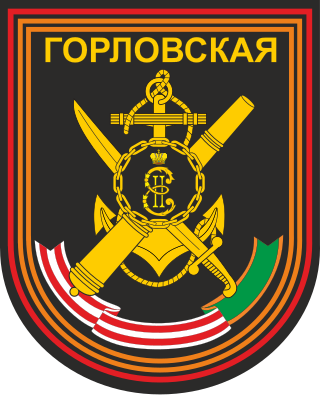The 134th Regiment of Foot was an infantry regiment of the British Army, created in 1794 and disbanded in 1796. The regiment was formed in Ireland by redesignating the newly raised 2nd Battalion of the 83rd Regiment of Foot, and did not leave Ireland before being disbanded in 1796.
The 129th Regiment of Foot was an infantry regiment of the British Army. It was created in 1794 and disbanded in 1796. The regiment was raised at Coventry, and was originally titled the Gentlemen of Coventry's Regiment of Foot, being retitled the 129th a few days later.

The Border Regiment was a line infantry regiment of the British Army, which was formed in 1881 under the Childers Reforms by the amalgamation of the 34th (Cumberland) Regiment of Foot and the 55th (Westmorland) Regiment of Foot.
The 125th Regiment of Foot was an infantry regiment of the British Army, created in 1794 and disbanded in 1796. It was raised at Stamford, Lincolnshire, under the colonelcy of Newton Treen.
The 123rd Regiment of Foot was an infantry regiment of the British Army, formed in 1762 and disbanded in 1764. Its colonel was John Pomeroy.
The 122nd Regiment of Foot was an infantry regiment of the British Army, formed in 1794 and disbanded in 1796.
The 119th Regiment of Foot was an infantry regiment of the British Army, formed in 1794 and disbanded in 1796.

The 119th Regiment of Foot was an infantry regiment of the British Army, formed in 1761 by the regimentation of independent companies and disbanded in 1763.
The 115th Regiment of Foot (Royal Scotch Lowlanders) was an infantry regiment of the British Army from 1761 to 1763.
The 114th Regiment of Foot was an infantry regiment of the British Army from 1794 to 1795. It was raised in April 1794 and was disbanded the following year.
The 114th Regiment of Foot (Royal Highlander Volunteers) was an infantry regiment of the British Army from 1761 to 1763.It was raised in October 1761, by Sir Allan MacLean of Torloisk. He was commissioned lieutenant in the 60th Foot Royal Americans at the beginning of the Seven Years' War and was severely wounded at Ticonderoga in 1758. He was then given one of the four NY Independent Companies until he returned to Scotland where he raised the 114th Maclean's Highlanders, or the Royal Highland Volunteers, as their Major Commandant. The regiment was disbanded in 1763.
The 109th Regiment of Foot (Bombay Infantry) was an infantry regiment of the British Army from 1862 to 1881, when it was amalgamated into The Prince of Wales's Leinster Regiment (Royal Canadians).
The 110th Regiment of Foot (Queen's Royal Musqueteers) was an infantry regiment of the British Army from 1761 to 1763.
The 108th Regiment of Foot was an infantry regiment of the British Army from 1761 to 1763. It was raised in October 1761 from a cadre of the 31st Regiment of Foot, and was disbanded in 1763.
The 126th Ohio Infantry Regiment, sometimes 126th Regiment Ohio Volunteer Infantry was an infantry regiment in the Union Army during the American Civil War.
The 126th Field Artillery Regiment was a regiment in the United States Army National Guard.

The 126th Brigade was an infantry brigade of the British Army during the First World War and the Second World War. It was assigned to the 42nd Division and served in the Middle East and on the Western Front in the Great War. In the Second World War, now as the 126th Infantry Brigade, it served again with the 42nd Division in France and was evacuated at Dunkirk and then later converted into 11th Armoured Brigade.

The 127th (Manchester) Brigade was an infantry brigade of the British Army that saw active service during both the First and Second World Wars. It was assigned to the 42nd Division and served in the Middle East and on the Western Front in the First World War.

The 126th Separate Guards Gorlovskaya Twice Red Banner, Order of the Suvorov Coastal Defense Brigade is a formation of the Coastal Defence Troops of the Russian Navy. Its Military Unit Number is 12676. It was granted the "Guards" honorific after suffering heavy losses in an unsuccessful attempt to capture Voznesensk, southern Ukraine, during the 2022 Russian invasion of Ukraine. The brigade is part of the 22nd Army Corps, Coastal Forces of the Russian Black Sea Fleet. The brigade's garrison is located in Perevalne, in the Simferopol region of the Russian-occupied Republic of Crimea.



